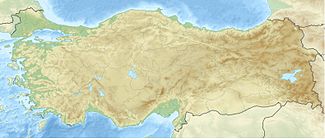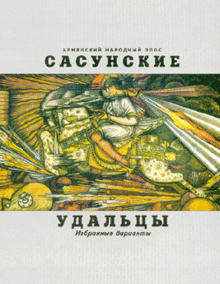- Daredevils of Sassoun
-
Daredevils of Sassoun
Սանա ԾռերAuthor folk Country  Armenia
ArmeniaLanguage Armenian Subject(s) Struggle of the people of Sassoun against the Arab invasion Genre(s) Epic poetry Publication date 1874 Published in English 1966 by Leon Zaven Surmelian
Daredevils of Sassoun (Armenian: Սասնա Ծռեր Sasna tsrer) is the title of an Old Armenian heroic epic / poem in four cycles (parts) and is about four generations of Sassoun's warriors. It is commonly cited as one of the most important works of Armenian folklore. This recital of the legendary deeds of four generations of strongmen in a warrior community in the Armenian highlands is in the tradition of heroic folktales that dramatize the story of a whole nation and voice its deepest sentiments and aspirations, but unlike such well-known epics as the Iliad and the Odyssey, Gilgamesh, Beowulf, Chanson de Roland, Poema el Cid and others one might mention, it has survived solely by word of mouth, transmitted from one generation to another by village bards. The literary merits of the Sassoun saga surpass its value as a historical or linguistic document.Contents
Background
Սասնա (Sasna) in Armenian refers to Sassoun - a region and a city located in Western Armenia, in the rugged mountain country southwest of Lake Van - in what is currently Batman Province, eastern Turkey. Ծուռ (Tsour) means crazy, mad, strongman, daredevil.
The most accurate and complete title of this epic is "Սասնա Ծռեր" (Daredevils of Sassoun). It has however been published under various titles:
- "Սասունցի Դավիթ" (David of Sassoun)
- "Սանասար և Բաղդասար" (Sanasar and Balthazar)
- "Սասունցի Դավիթ կամ Մհերի դուռ" (David of Sassoun or Meher's door)
and many others. All these titles correspond with four cycles of the epic.
The written literature of Armenia goes back to fifth century of our era, its Golden Age, when the Bible was translated into the vernacular from the original Greek and Syriac texts, Plato and Aristotle were studied in Armenian schools, and many original works of great interest to the modern specialist were produced by native historians, philosophers and poets. The oral literature is older that the written, and folk poetry had flourished in Armenia for the past two thousand years, not to go farther back. Movses Khorenatsi (Moses of Khoren) tells us in his classic "History of Armenia" (fifth century) that Armenians still loved the pagan "songs" the minstrels sang on festive occasions, and he quotes from them. Only these fragments of pagan "songs" have survived to this day.
Songs celebrating memorable events have retained their hold on the popular imagination, and one might say that Armenians are preeminently a nation made by the book and the folk song, the word, written and spoken or sung. But the spoken word is more perishable than the written, and little has survived.
Discovery of the story
The story of Sassoun - the greatest achievement of the oral literature - was "discovered" in 1873 by a bishop of the Armenian Apostolic Church, Garegin Servantstian, who had exceptionally close contacts with the peasantry in the more remote inaccessible parts of Western Armenia, where life had not changed much for thousand years or so. He says:
For three years I tried to find somebody who knew the entire story, but nobody seemed to know all of it until I met Gurbo from a village on the Moush plain. I learned that his master had two pupils who also knew the tale by heart, singing verses in it, although Gurbo himself had not recited it for so long that he had forgotten a good deal of it. Nevertheless, I kept him with me for three days, I begged him, cajoled him, honored him, rewarded him, and when he felt better and was in the proper mood, he recited the tale for me in his own village dialect, and I wrote it all down in his own words.The tale told by Gurbo was published in Constantinople (Istanbul) in 1874 under the title David of Sassoun or Meherr's Door. The bishop wrote in the introduction:
The life of David and his exploits belong in the Middle Ages... The entire story is a record of courage, of domestic virtue, of piety, and of simple, open-hearted relations with his beloved woman as well as with his enemies. Despite its irregularities and anachronisms it has some fine stylistic qualities and narrative devices in it... The publication of this tale would be of interest to the understanding reader, but I suppose there will also be those who will express their contempt for it and abuse both the story and my own person. These readers will not understand it. But it does not matter. I shall consider myself encouraged if I find twenty sympathetic readers".Language
Though the language abounds in poetic pictures, the physical sensory details are often missing. This is because an oral tale is necessarily different from that of a written story. The reciter would get on with his action and act out most parts of the story to hold interest of his audience, plot is the main thing, and the reciter suits the words of action. It's written in a beautifully controlled language and hyperbole is a characteristic device of this epic style.
Publications and translations and other media
In 1881 "Sasna Dzrer" was translated into Russian. Later the tale was translated into the languages of all fifteen republics of the Soviet Union. Next the text was translated into French and Chinese.
Other variants of this folk epic have been published since 1874, and there are some fifty of them altogether. If bishop Garen Servantstian saved the Armenian epic from oblivion, sixty years later Dr. Manouk Abeghian of the Armenian Academy of Sciences rendered an almost equally valuable service with his co-workers by collecting nearly all these variants in three scholarly volumes published by the State Publishing House in Yerevan, Armenia in 1936, 1944 (part l)and 1951 (part ll), under the general title "Daredevils of Sassoun" (Sasna Dzrer). All three volumes contain over 2,500 pages of text. In 1939 a collated text weaving most of the important episodes together was published for popular reading under the title "David of Sassoun". As village texts are in various dialects, which presents many difficulties to the modern reader, the story was reworded and a fairly uniform style comprehensible to Eastern Armenian dialects was adopted. From 1939 until 1966 all translations were made from this popularized text. In 1966 Leon Zaven Surmelian, Armenian-American author, translated the epic into English from its original village stories under the name Daredevils of Sassoun.
First part of Daredevils of Sassoun saga was adapted into a feature length animated film, first of its kind in the Republic of Armenia. Director: Arman Manaryan, head-animator Vardan Zakarian. The film was released in Armenia and Russia on January 25, 2010.
See also
References
- Publisher Alan Swallow; 1st THUS edition (1964) ASIN: B000TK0I3A
- Publisher George Allen & Unwin (1966)
- http://artbridge.am/store/item.php?catid=&prid=10779
- http://hy.wikipedia.org/wiki/%D5%8D%D5%A1%D5%BD%D5%B6%D5%A1_%D5%AE%D5%BC%D5%A5%D6%80
- http://encyclopedia.am/pages.php?bId=2&hId=1585
- http://www.amazon.com/gp/product/B000TK0I3A
Categories:- Armenian culture
- Epic poems
Wikimedia Foundation. 2010.


